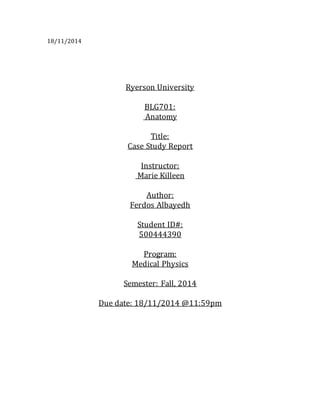
Case Study Report on an Injured Man While Rock
- 1. 18/11/2014 Ryerson University BLG701: Anatomy Title: Case Study Report Instructor: Marie Killeen Author: Ferdos Albayedh Student ID#: 500444390 Program: Medical Physics Semester: Fall, 2014 Due date: 18/11/2014 @11:59pm
- 2. Case Study Report This case study is about a 31-year-old man, who got injured from rock-climbing. He fell from an 18 feet to the ground. This case study carries medical observations to be discussed. Therefore, this report will contain a brief explanation on the body reaction, some observations on the case and lab studies observations (Killeen, 2014). The primary problem is the patient got injured while rock-climbing. He suffered from blood loss because he fell; he was soaking in blood; his right femoral ‘thigh’ artery ‘blood vessel’ was possibly ripped because that is where the tourniquet is located (Killeen, 2014). The patient’s body would probably react with a decrease in blood pressure because he lost a lot of blood. The heartbeat would go faster, and vasculature would tighten all supportive nervous systems. In addition, platelet coagulation begins, which is a blood particle involved in clotting. Then, epinephrine would rise. Epinephrine is a hormone, which is drawn in the fight or flight reaction in humans ((Adrenaline)? & Cashin-Garbutt, 2012). Furthermore, the blood is preserved by ADH, which is known as an Anti-Diuretic Hormone ‘ADH’. It organizes the permeability of the gathering channel to the water (163.16.28.248, 2014). According to the case study, there were several observations made due to the patient’s loss of blood. First, the orthostatic hypotension and the cause of it is low blood volume. Low blood pressure equals low blood volume. The orthostatic hypotension is a type of low blood pressure and it usually occurs when standing up or sitting down. Its symptoms are dizziness or faintness (Mayoclinic.org, 2014). Second, pale nail beds. It could be the cause of vasoconstriction; it narrows the blood vessels by making small muscles in their walls (Nlm.nih.gov, 2014). Then, the blood flow is lowered or blocked from reaching the extremities. Last but not least, disorientation, which is a feeling of being lost or uncertainty of one’s location and lethargy, refers to the feeling of slowness, lack of energy, and tiredness (Rightdiagnosis.com, 2014). The reason behind this is a low blood volume, which leads to reduced blood flow to the brain. Which means there isn’t enough oxygen entering the brain for it to function normally. The laboratory studies showed that his urinary output was not normal. Thus, he is dehydrated. If there were no enough blood flow to the kidneys, a severe rejection of kidney function occurs. The patient was given two units of whole blood. However, the hematocrit was in a normal range ‘amount of red blood cells in percentage’ (Nlm.nih.gov, 2014). Assuming because the patient lost a lot of blood due to the fall, meaning low blood volume and the system needs a whole blood to gain back what the blood lost (Killeen, 2014).
- 3. In conclusion, such incident could cause trauma and bleeding, which result to many deficiencies in the human body as a reaction. The patient was a bit lucky that he did not suffer from any major injury that could have caused for his death or more painful and longer period of recovery. Accidents like this happen with no alert. However, it can be prevented with more caution.
- 4. Reference: (Adrenaline)?, W., & Cashin-Garbutt, A. (2012). What is Epinephrine (Adrenaline)?. News-Medical.net. Retrieved 19 November 2014, from http://www.news- medical.net/health/What-is-Epinephrine-%28Adrenaline%29.aspx 163.16.28.248,. (2014). Chapter 46 - Antidiuretic hormone (ADH). Retrieved 19 November 2014, from http://163.16.28.248/bio/activelearner/46/ch46c1.html Mayoclinic.org,. (2014). Orthostatic hypotension (postural hypotension) Definition - Diseases and Conditions - Mayo Clinic. Retrieved 19 November 2014, from http://www.mayoclinic.org/diseases-conditions/orthostatic- hypotension/basics/definition/con-20031255 Nlm.nih.gov,. (2014). Vasoconstriction: MedlinePlus Medical Encyclopedia. Retrieved 19 November 2014, from http://www.nlm.nih.gov/medlineplus/ency/article/002338.htm Rightdiagnosis.com,. (2014). Lethargy - RightDiagnosis.com. Retrieved 19 November 2014, from http://www.rightdiagnosis.com/sym/lethargy.htm Nlm.nih.gov,. (2014). Hematocrit: MedlinePlus Medical Encyclopedia. Retrieved 19 November 2014, from http://www.nlm.nih.gov/medlineplus/ency/article/003646.htm Killeen, M. (2014). Case Study for BLG701 Fall 2014 (pp. 1-2). David A. Sandmire, M.D., Marie Killeen.